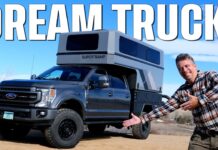
Colorado legislature passed a bill (Senate Bill 17-278) this week that makes it illegal to “knowingly blowing black smoke through one or more exhaust pipes attached to a motor vehicle”. The bill is titled “CONCERNING A PROHIBITION AGAINST ENGAGING IN A NUISANCE EXHIBITION OF MOTOR VEHICLE EXHAUST.”
What is black diesel smoke or rolling coal?
Many (but not all) diesel-powered vehicles emit some level of visible black smoke (or particulates) out of the exhaust pipe. This generally applies to older diesel or turbo-diesel vehicles. Simply put, visible black smoke is unburnt diesel fuel leaving the vehicle. Generally, this happens when there is more diesel fuel being injected into the engine than there is oxygen to completely burn it. More fuel means more power, but too much fuel means there can be visible smoke.
Most brand new turbo-diesels are so well-tuned from the factory that they emit no visible particulates. Check this video of a 2016 Ram 1500 EcoDiesel being tested at a Colorado Emissions Testing Facility. This pickup truck registered 0% exhaust opacity at various speeds and engine loads.
Why is black diesel smoke bad?
Excessing diesel smoke (or diesel particulates) is bad because diesel particulates have been proven to be carcinogenic (have potential to cause cancer). Inhaling diesel particulates negatively affects your health. The other negative affect is that too much smoke obscures vision of others and creates a safety hazard.
What is opacity?
Opacity is the amount of light being blocked. If something has 0% opacity, then you can see 100% of light through it. If something has 35% opacity, then 35% of the light is being blocked (or you can see 65% of the light).
What level of visible diesel smoke emissions is considered legal in Colorado?
Colorado law says that turbo-diesel vehicles that emit smoke at 35% opacity or less are legal. An older well-maintained turbo-diesel passenger vehicle or pickup truck may emit particulates between 5-8% opacity. 5% opacity is what many consider “barely visible” to the human eye. Emissions test facilities use a laser light to measure a vehicle’s exhaust opacity.
Which vehicles are affected by the regulation?
Non-commercial vehicles at or under 14,000 lbs of Gross Vehicle Weight Rating (GVWR) are affected by the regulation. This bill specifically targets pickup trucks and other private vehicles in an effort to prevent an exhibition of black smoke.
How much black smoke is illegal?
The bill states the following, “KNOWING RELEASE OF SOOT, SMOKE, OR OTHER PARTICULATE EMISSIONS FROM A MOTOR VEHICLE INTO THE AIR AND ONTO ROADWAYS, OTHER MOTOR VEHICLES, BICYCLISTS, OR PEDESTRIANS, IN A MANNER THAT OBSTRUCTS OR OBSCURES ANOTHER PERSON’S VIEW OF THE ROADWAY, OTHER USERS OF THE ROADWAY, OR A TRAFFIC CONTROL DEVICE OR OTHERWISE CREATES A HAZARD TO A DRIVER, BICYCLIST, OR PEDESTRIAN.” The bill does not define a level of opacity which is illegal. The smoke that obscures another person’s view is said to be illegal.
What is the enforcement and penalty of this law?
It would be up to the law enforcement officer to determine whether the amount of smoke violated the law. This is considered a Class A traffic infraction with a penalty of $100.
Here is a video of several street-driven pickups, race trucks, and semi trucks racing at a local drag strip. Most of these tuned trucks are blowing diesel smoke (rolling coal) in an effort to get a fast 1/4 mile time.
















![Which is More Reliable: 3.5L EcoBoost or 5.0L V8? [Reader Question] Second-generation 3.5-liter EcoBoost engine](https://tfltruck.com/wp-content/uploads/2016/05/Second-generation-35-liter-EcoBoost-engine.jpg)
![Which Silverado Engine to Get: 5.3L or 6.2L V8? [Ask TFLTruck] 2016 chevy silverado](https://tfltruck.com/wp-content/uploads/2015/10/2016-chevy-silverado-grille.jpg)
